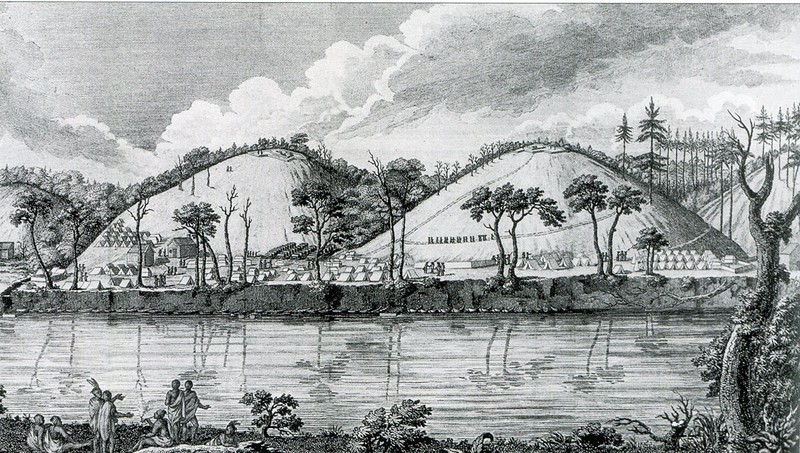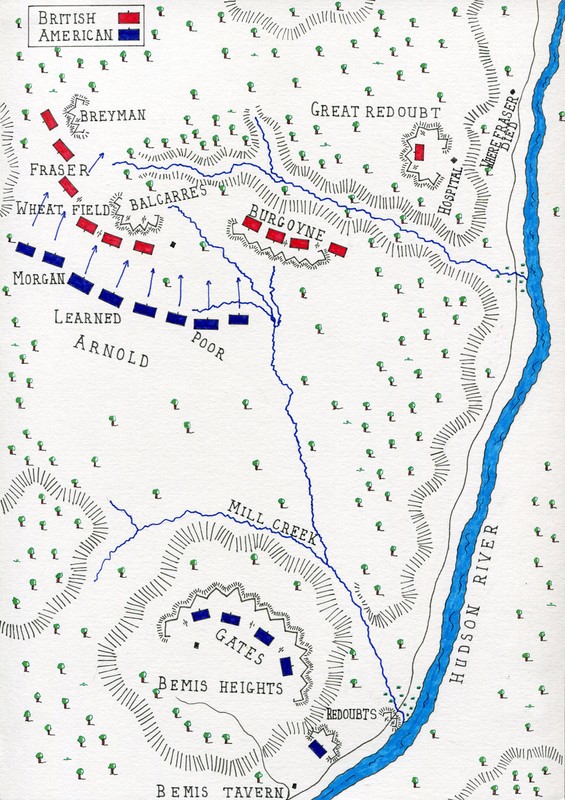British Camp at Saratoga
Introduction
Text-to-speech Audio
Within this region, the British set their camp for the two battles of Saratoga. The British forces were led by General John Burgoyne. The British aimed to gain control of the Hudson River Valley through their Saratoga Campaign. Burgoyne started the campaign by moving 7,500 British regulars from Canada, where they had captured Fort Ticonderoga and Fort Edward by August. In September, the British would meet the American forces led by General Horatio Gates around Saratoga.
Images
Depiction of British lines at Saratoga across the Hudson River

Map of American attack on Oct. 7th 1777 by John Fawkes

Backstory and Context
Text-to-speech Audio
The British believed that their control of New York, prior to the Saratoga Campaign, would mean the taking of the Hudson River Valley would be child's play once they took Albany (Revolutionary War). At first, that looked to be the case, as Burgoyne took Fort Ticonderoga easily. After the British had taken Ticonderoga, the march further south became much more difficult. The terrain the British went through was a dense forest area that made movement slow down considerably. Thus Burgoyne sent forces, lowering his overall numbers, north to gather supplies and a contingent of indigenous people returned home (Revolutionary War). Then American General Benjamin Lincoln started attacking the British army from behind. This allowed the Americans to prepare their defenses around Bemis Heights and prepare for the coming battles around Saratoga.
Following the First Battle of Saratoga, around Freeman's Farm, the British called for additional reinforcements from New York City. British General Henry Clinton stated that reinforcements from New York City would arrive to support Burgoyne in Saratoga, but the closest Clinton's forces would get to Burgoyne was roughly 70 miles (Revolutionary War).
During the Saratoga campaign, the British forces faced limited rations and Burgoyne was forced to limit the rations of his men. Burgoyne decided on October 7 to attack the American forces around Bemis Heights. While the British received no reinforcements, "the Americans had been joined by General Lincoln's forces plus a steady stream of militia men" (Revolutionary War). The reinforced American forces easily repelled the British attack, even coming close to killing Burgoyne.
The British forces were forced back to two different redoubts, temporary defensive structures, which the Americans would push the weakened British forces out. Thus on October 17, 1777, the British under Burgoyne surrendered and gave control of the Hudson River Valley to the American forces. In the spring of 1778, Burgoyne returned to England and was criticized severely for his actions and given "no future commands in the British Army" (Battlefields) The Saratoga Campaign played an additional role for the Americans. The French were impressed by the Americans' resistance and signed "a formal Treaty of Alliance with the Americans" (Battlefields) and the balance of the war tipped in the favor of the Americans and their new ally the French.
Sources
Saratoga: Freeman's Farm/Bemis Heights, Accessed May 5th, 2023. https://www.battlefields.org/learn/revolutionary-war/battles/saratoga.
The Battle of Saratoga: The Battles of Freeman's Farm and Bemis Heights, Revolutionary War. Accessed May 5th, 2023. https://www.revolutionary-war.net/the-battle-of-saratoga/.
The Battle of Saratoga, US History. Accessed May 5th, 2023. https://www.ushistory.org/us/11g.asp.
https://www.britishbattles.com/war-of-the-revolution-1775-to-1783/battle-of-saratoga/
https://www.britishbattles.com/war-of-the-revolution-1775-to-1783/battle-of-saratoga/
